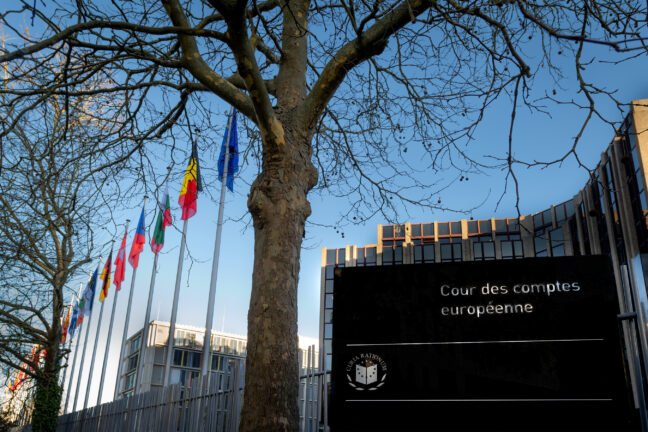Brussels likes tidy ledgers. Yet its flagship scheme for narrowing Europe’s wealth gaps is a shambles, says the European Court of Auditors. The watchdog has published a withering study of how the European Commission polices the claw-backs of misspent cash. The findings read like an instruction manual left unopened.
In their 20 November report, the auditors did not mince words. “Any expenditure which is in breach of the applicable law must be excluded from EU financing, thereby helping to safeguard the budget of the Union,” declared François-Roger Cazala, the member in charge of the probe. He added: “It should be noted that the European Commission has not always applied financial corrections when and where necessary.” His team uncovered a system hobbled by vague rules, endless talks and vanishing penalties.
Their starting point was simple arithmetic. From 2014 to 2020 the EU set aside €404.8bn, including a pandemic top-up, for roads, railways, research labs and retraining schemes. Member states run the projects and must repay Brussels if something goes wrong. If they refuse, the Commission should dock money directly through “mandatory net financial corrections”. In theory that keeps local ministries honest and protects the common purse.
Room for improvement
In practice the mechanism resembles an unused fire extinguisher. The Commission admitted that its own checks since 2014 had sparked €1bn of national corrections. A further €200m followed ECA audits. Yet mandatory net corrections—supposed to be the big deterrent—arrived only once, in September 2025, more than a decade after the tool was unveiled. Meanwhile annual error rates in cohesion spending stayed stubbornly high.
Why the delay? The court points to law that ties itself in knots. Brussels may punish only “acts or omissions by an economic operator”. That clause excludes the programme authorities who oversee most of the money and often make the gravest mistakes. Serious deficiencies in national control systems still occur, but the legal link to penalties becomes blurred. Guidance on what counts as serious also shifts from case to case, breeding argument and inertia.
You might be interested
Timing looks just as murky. The auditors reviewed ten countries and found the Commission spent an average of 588 days—nearly two years—negotiating with capitals before it even opened a correction procedure. Once proceedings began they dragged on for another two-plus years. In total, a suspect payment could sit unchallenged for up to four years. That leaves the budget exposed and blunts any deterrent bite.
What the court wants
The report sets out four blunt recommendations. First, apply the rules as written. When an irregular payment pops up, claw it back and do not let capitals duck audits. Second, be quicker. Deadlines at every stage would stop talks drifting. Third, be consistent. Staff across directorates should read deficiencies in the same way, so similar sins earn similar fines. Fourth, shed light. Publish full, accurate figures on all corrections, not just headline claims.
Any expenditure which is in breach of the applicable law must be excluded from EU financing, thereby helping to safeguard the budget of the Union. — François-Roger Cazala, European Court of Auditors
None of this sounds radical. Yet the Commission faces a culture change. Officials worry that hard penalties may sour relations with governments whose help they need on other files. Finance ministries argue that talks allow them to fix weak systems without losing precious cash. The court counters that cordial chats have failed: a single mandatory correction in ten years suggests little fear of punishment. Without sharper sticks, says the report, member states may let sloppy paperwork linger and hope Brussels never bites.
Slow to swing the axe
Examples stack up. In sixteen files that met all the conditions for a mandatory net correction, the Commission launched the procedure only twice, and neither case has yet finished. Elsewhere it slashed planned claw-backs or dropped them entirely, often without recording clear reasons. Such discretion, the auditors warn, “gives the impression of uneven treatment and undermines credibility”. Beneficiaries learn that with enough lobbying the bill can shrink.
The court also frets about reporting. Public documents bundle national and EU corrections together, hide reversals and arrive late. That makes it hard for parliaments—or taxpayers—to see whether the system works. A tidy spreadsheet of every error, every negotiation and every cent repaid would expose foot-dragging. Transparency, say the auditors, is pressure.
The Commission replies that reform is already under way. A new regulation for 2021-2027 tweaks definitions of serious deficiency and lets Brussels apply flat-rate corrections when documentation is poor. But the ECA notes that the revamped law still omits firm deadlines and keeps the muddled focus on economic operators. In other words, more of the same.
Why it matters
Cohesion spending ranks among the EU’s biggest cheques and boldest promises. It funds metro lines in Warsaw, business incubators in Seville and broadband in rural Latvia. Mis-spent money hurts not only local taxpayers but faith in the European project. Brussels can ill afford that at a time when some governments already rail against the club’s rules.
Financial corrections are meant to police the border between solidarity and waste. When they fail, two risks emerge. Money keeps leaking into dodgy contracts, and honest regions see their coffers squeezed to make up the losses. The court’s advice—follow the rules, hurry up, treat everyone alike—echoes schoolyard logic. Yet it may provoke a political tussle.
It should be noted that the European Commission has not always applied financial corrections when and where necessary. — François-Roger Cazala
Capitals with heavy cohesion allocations fret about sudden cuts. Southern and eastern regions, still catching up with the west, lobby ferociously to keep funds flowing. The Commission, anxious to show unity, often prefers gentle nudges to swinging axes. But gentle nudges have not stopped the errors. The auditors believe only visible, timely penalties will change behaviour.
A test for trust
The next months offer a test. The lone mandatory correction approved in 2025 must now pass the final legal hurdles. If Brussels sees that case through—and publishes the numbers—others will follow. If it wavers, the signal that corners can be cut will grow louder.
Meanwhile the European Parliament, which pores over the budget each spring, may seize on the ECA’s findings. MEPs enjoy grilling commissioners about every euro. They could insist on a public dashboard of corrections and push for stricter clauses when the cohesion rules come up for mid-term review.
Mr Cazala and his fellow auditors have done the arithmetic and proposed the fixes. The Commission never lacks for statements on good governance. What counts now is action on the ground: clear guidance, quick deadlines, fearless penalties and full disclosure. Cohesion funds aim to knit Europe together. That mission will look stronger when taxpayers—north, south, east and west—know the money flows only where rules are followed.
Until then the fire extinguisher hangs on the wall, shiny yet barely used. The court’s message is plain: pull the pin, aim, and squeeze.





